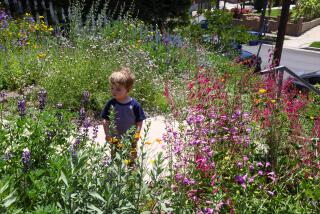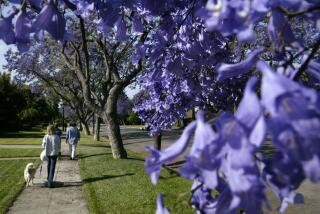Keeping a Big Garden Business in Flower
- Share via
Just like many of us, a lot of the lush flowers and plants in California are immigrants too. And just like many of us, they often do better here than they did in their native lands.
Which brings us to the drought and how it’s affecting the multibillion-dollar California lawn and garden business.
Californians spent $4.2 billion last year on gardening and landscaping, and that represents 26% of the national total, according to the California Assn. of Nurserymen. We plant, fertilize, mulch, weed, mow, trim and water more than any other Americans. Our gardens grow, and need care, all year.
The trouble is, most of California has a dry, Mediterranean climate. It doesn’t rain much. It’s naturally green in the winter and brown in the summer. Nature did not put roses and dichondra here; people did.
But, for a century, one of California’s abiding attractions has been its lushness, made possible by watering. Boosters have touted our ability to grow anything. Deserts bloom here; green lawn, abundant foliage and riotous color can be enjoyed year-round, as long as you water. It seems as if all you need is a garden hose.
The California lawn and garden industry sprouted to provide those hoses and the countless other supplies used by gardeners and landscapers, both amateur and professional. It also imports or grows all the beautiful and exotic plants seen in our parks, landscapes and back yards.
This gentle, dream-fulfilling business really took off after World War II, with the advent of “garden centers” that sold everything from seed to tractors. The business of growing shrubs, flowers and decorative plants went from farmer’s sideline to major industry, with corporate-owned nurseries propagating millions of trees, flowers and plants.
The climate was perfect, and engineers made the water available.
But now the state is in the fourth year of a drought. It’s the second time in 15 years that California has suffered a bad dry spell. In addition, traditional water sources for California, such as the Colorado River, may soon be virtually unavailable. But the state’s population continues to grow, especially in the water-parched south. Experts talk of chronic water shortages.
Some areas, particularly Santa Barbara, are much harder hit than others, and they have slapped restrictions on landscaping and watering. Lawns are brown, gardens are dry and the garden industry in those areas is worried.
But even in areas less affected by the drought, the water situation is provoking anguish and a debate over the future of the business. The key question seems to be whether California’s famed lushness will have to wither, replaced by “drought-tolerant” or “water-wise” flowers and plants.
“We all need to awaken to the realities and make intelligent changes in water usage,” said Lew Whitney, president of Rogers Gardens, a Newport Beach nursery. “Maybe we don’t need dichondra or Kentucky blue grass, but maybe we all don’t have to have concrete lawns and cactus gardens either.”
Some in the industry believe that the drought will force Californians away from the thirsty flowers and leafy plants that became popular here when water was cheap and abundant. The situation may finally bring a boom for the so-called California natives, they say, the varieties that were here before the immigrants.
“I think people will give up their current preferences if forced to by the water shortage,” said Therese Thompson, acting manager of the Theodore Payne Foundation, a nonprofit group in Sun Valley that promotes the use of plants that are native to the state. “They’ll find out how beautiful the natives are.”
Others boost something called xeriscaping, a fancy term that basically means planting varieties that are appropriate to the climate and the amount of rainfall. The trouble is, there’s not much agreement on what’s appropriate to California.
And the majority sentiment in the mainstream lawn and garden business is that many California native plants and drought-tolerant species are too plain and too delicate to find broad public acceptance. They blossom for too short a period, some say, and they often don’t look “lush.”
The industry is aware, however, that it must adapt to the reality of water shortages. So far, that has meant a major campaign to educate people about the evils of over-watering and the need to be more efficient with the water they use.
At the Pacific Horticultural Trade Show in Los Angeles this month, manufacturers and distributors displayed dozens of water-saving devices, from gadgets to computer-controlled systems. There were battery-operated sprinkler timers, flow-restriction nozzles and drip irrigation systems.
Clearly, the message from the industry was that California should be able to save its lushness if it just does a better job of watering. Nine out of 10 gardening problems reported by customers are because of over-watering, several representatives said.
But there is also an undertone of concern in the industry. Sales have slowed in recent months; some think that that’s because of a general economic slowdown and California’s very hot summer this year. But some also worry that people are more aware of the drought and aren’t planting as much.
If that’s true, it could spell big trouble.
“We have to pull our heads out of the sand and realize there is a long-term shortage,” said John Bauman, general manager of Palos Verdes Begonia Farm. “We have to get out there and re-educate our customers about watering. The trouble is, some (in the industry) are afraid to do that for fear of scaring people away.”
Luckily for the industry, the need to “manage” watering dovetails nicely with another trend: the lack of time by many gardeners to water their gardens. Sales of sprinkler timing devices and automatic irrigation systems are soaring, perhaps because they save as much labor as water.
The industry’s response to the drought so far has amounted to crossing its fingers, in the hope that knowing how to use water will save the way we’ve grown things since we first brought in enough water to create the lushness we like.






